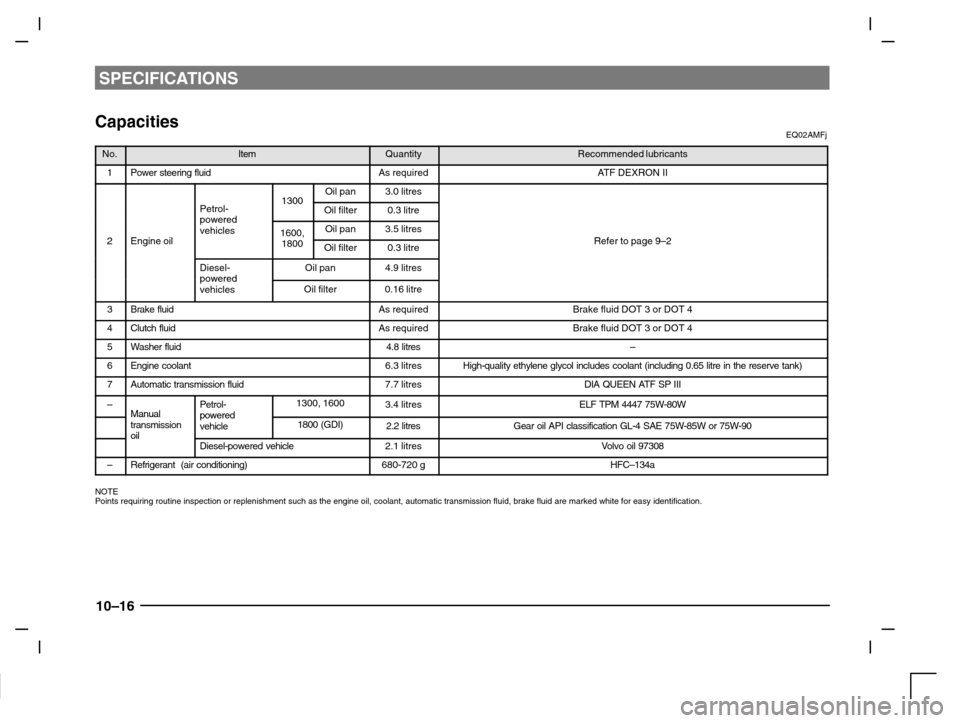Page 240 of 280

MAINTENANCE
9–2
EM01A -Fh
Adequate care of your vehicle at regular in-
tervals serves to preserve the value and ap-
pearance as long as possible.
Some maintenance items can be carried out
by the owner (do it yourself), while others
should be carried out by an authorized MIT-
SUBISHI dealer (periodic inspection and
maintenance). This section describes only
those items which can be carried out by the
owner. In the event a malfunction or other
problem is discovered, have it corrected by
an authorized MITSUBISHI dealer. This sec-
tion contains information on inspection main-
tenance procedures that you can do your-
self, if you wish to do so. Follow the
instructions and cautions for each of the va-
rious procedures.
WARNING
(1)When checking or servicing the in-
side of the engine compartment,
make sure the engine is switched
off and has had a chance to cool
down.
(2)If it is necessary to do work in the
engine compartment with the en-
gine running, be especially careful
that your clothing, hair, etc., does
not become caught by the fan,
drive belts or other moving parts.
WARNING
(3) The fan may turn on automati-
cally even if the engine is not run-
ning; turn the ignition key tothe
“LOCK” position and remove the
key to ensure safety while you
work in the engine compartment.
(4) Do not smoke, cause sparks or
allow open flames around fuel or
battery. The fumes are flammable.
(5) Be extremely cautious when
working around the battery. It
contains poisonous and corros-
ive sulphuric acid.
(6) Do not get under your vehicle
with just the body jack support-
ing it. Always use automotive
jack stands.
(7) Improper handling of compo-
nents and materials used in the
vehicle can endanger your per-
sonal safety.
Consult an authorized MITSUBI-
SHI dealer for necessary informa-
tion.
Petrol-powered vehicles (1300 models)
M03A088a
Engine oil
EM03A–Id
The engine oil used has a significant effect
on the engine’s performance, service life and
startability. Be sure to use oil of the recom-
mended quality and appropriate viscosity.
All engines consume a certain amount of oil
during normal operation (See note below).
Therefore, it is important to check the oil at
regular intervals or before starting a long
journey.
Page 245 of 280

MAINTENANCE
9–7
BatteryEM37A–Pd
The condition of the battery is very important
for quick starting of the engine and proper
functioning of the vehicle’s electrical system.
Regular inspection and care are especially
important in cold weather.
NOTE
(1) After replacing the battery, the electronic
control system data for the engine, auto-
matic transmission, etc., will be erased.
As a result, the engine speed may be-
come unstable and shift shocks may
occur.
If the engine speed become unstable,
initial engine adjustments will need to be
performed.
Refer to the section “What to do if the
engine speed becomes unstable after
the battery is replaced:” on page 8–22.
Shift shocks will become smoother after
several changes in speed.
(2) Memory data for settings made by the
user may be erased when the battery is
replaced. If this happens, establish the
settings again using the relevant pro-
cedures.
M37B003a
Checking battery electrolyte level
The electrolyte level must be between the
“max” and “min” marks stamped on the out-
side of the battery. Replenish with distilled
water as necessary.
The inside of the battery is divided into sev-
eral compartments; remove the cap from
each compartment and fill to the “max” mark.
Do not over -replenish beyond the “max”
mark because spillage during driving could
cause damage.
Check the electrolyte level at least once
every four weeks, depending on the operat-
ing conditions.
If the battery is not used, it will discharge by
itself with time. Check it once every four
weeks and charge with low current as
necessary.
During cold weather
The capacity of the battery is reduced at low
temperatures. This is an inevitable result of
its chemical and physical properties. This is
why a very cold battery, particularly one that
is not fully charged, will only deliver a fraction
of the starter current which is normally avail-
able.
It is recommended that you have the battery
checked by an authorized MITSUBISHI
dealer before the start of cold weather and,
if necessary, have it charged.
This not only ensures reliable starting, but a
battery which is kept fully charged also has
a longer life.
Disconnection and connection
To disconnect the battery cable, stop the en-
gine, first disconnect the negative (–) ter-
minal and then the positive (+) terminal.
When connecting the battery, first connect
the positive (+) terminal and then the nega-
tive (–) terminal.
Page 270 of 280
SPECIFICATIONS
10–12
Other specificationsEP01IMDb
ItemPetrol-powered vehicleDiesel powered vehicleItem1300, 16001800 (GDI)Diesel-powered vehicle
Fuel controlMulti-point injectionGasoline direct injectionInjectionFuel systemFuel pumpElectric motor typeElectric motor and
Mechanical single plunger typeCommon rail type
ClutchDry single disc clutch with diaphragm spring, hydraulic action
Steering systemRack and pinion type, power assisted
SuspensionFrontIndependent type, Mac Pherson sturt, coil springSuspensionRearIndependent type, multi-link, coil spring
TypeHydraulic, diagonally connected double circuit system with power assistance, anti-lock brake*
Service brakesFrontVentilated disc brakes
RearDisc brakes
Parking brakesParking brake acts mechanically on rear wheels
*: Option
Page 274 of 280

SPECIFICATIONS
10–16
CapacitiesEQ02AMFj
No.ItemQuantityRecommended lubricants
1Power steering fluidAs requiredATF DEXRON II
1300Oil pan3.0 litres
Petrol-powered
1300Oil filter0.3 litre
2Engine oil
powered
vehicles1600,Oil pan3.5 litresRefer to page 9 22Engine oil1800Oil filter0.3 litreRefer to page 9–2
Diesel-poweredOil pan4.9 litrespowered
vehiclesOil filter0.16 litre
3Brake fluidAs requiredBrake fluid DOT 3 or DOT 4
4Clutch fluidAs requiredBrake fluid DOT 3 or DOT 4
5Washer fluid4.8 litres–
6Engine coolant6.3 litresHigh-quality ethylene glycol includes coolant (including 0.65 litre in the reserve tank)
7Automatic transmission fluid7.7 litresDIA QUEEN ATF SP III
–ManualPetrol-powered1300, 16003.4 litresELF TPM 4447 75W-80WManual
transmission
oil
powered
vehicle1800 (GDI)2.2 litresGear oil API classification GL-4 SAE 75W-85W or 75W-90oilDiesel-powered vehicle2.1 litresVolvo oil 97308
–Refrigerant (air conditioning)680-720 gHFC–134a
NOTE
Points requiring routine inspection or replenishment such as the engine oil, coolant, automatic transmission fluid, brake fluid are marked white for easy identification.